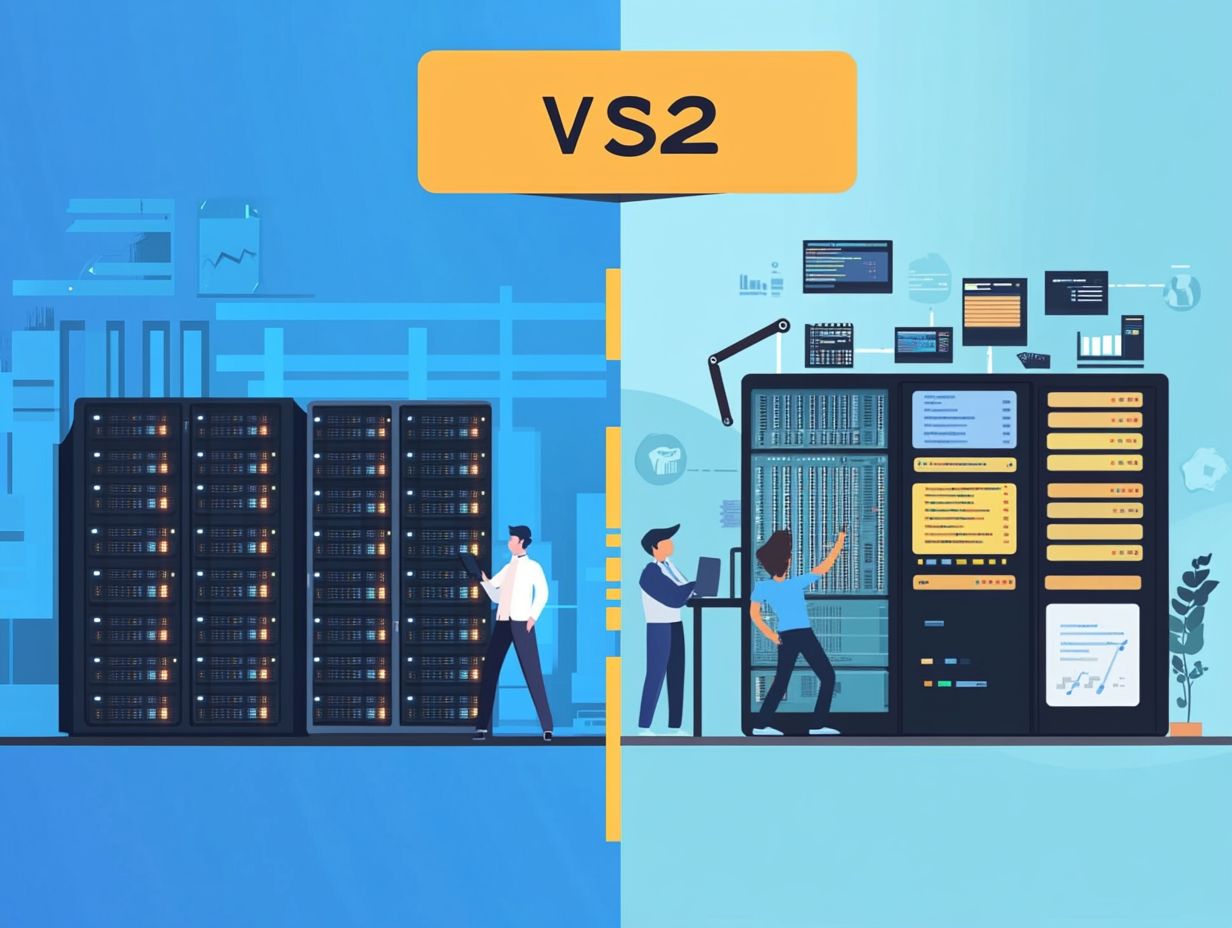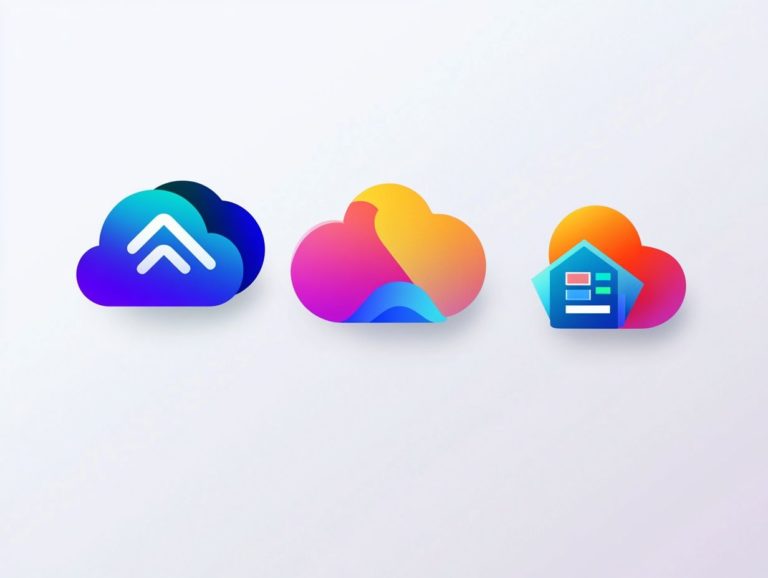Key Differences Between IaaS and PaaS Providers
In today s cloud computing landscape, Infrastructure as a Service (IaaS) and Platform as a Service (PaaS) stand out as two pivotal models that can significantly enhance your business’s innovation and efficiency.
Grasping their features is essential for any organization aiming to optimize operations. This article delves into the defining characteristics of IaaS and PaaS providers, offering a comparison of their infrastructure offerings, scalability, and development tools.
You ll also find key considerations for selecting the right provider tailored to your business needs and technical requirements. Don t miss out! Dive in now to discover which model is perfect for your goals!
Contents
- Key Takeaways:
- Features of IaaS Providers
- Features of PaaS Providers
- Comparison of IaaS and PaaS Providers
- Key Considerations When Choosing a Provider
- Frequently Asked Questions
- What is the main difference between IaaS and PaaS providers?
- What are the key differences in terms of scalability?
- How do pricing models differ between IaaS and PaaS providers?
- What level of customization is available with IaaS and PaaS providers?
- Which is more suitable for beginners – IaaS or PaaS providers?
- What are the security implications of using IaaS and PaaS providers?
Key Takeaways:

IaaS providers offer basic infrastructure services while PaaS providers offer a complete development platform.
IaaS providers focus on flexibility and scalability, while PaaS providers offer development tools and support.
When choosing a provider, consider your business goals and technical requirements to determine the best fit for your needs.
What are IaaS and PaaS?
Infrastructure as a Service (IaaS) and Platform as a Service (PaaS) are transforming the landscape of cloud computing, fundamentally altering how enterprise businesses deploy, manage, and scale their IT resources.
With IaaS, you gain access to virtual computing resources over the internet, including remote servers and data storage. This model gives you great flexibility and control over your infrastructure, especially beneficial if you aim to minimize hefty upfront hardware investments while adapting to fluctuating workloads.
On the flip side, PaaS provides you with a robust platform for application development and deployment tools. This allows you to concentrate on crafting software applications without the burden of managing the underlying infrastructure.
Both IaaS and PaaS seamlessly connect with various services, including Application Programming Interfaces (APIs) and data management tools, enhancing collaboration and boosting operational efficiency.
By harnessing these cloud models, you can elevate customer engagement with more responsive applications. Accelerating deployment cycles nurtures innovation and integrates technology into your workflows more effectively.
Features of IaaS Providers
IaaS providers present a rich array of features designed to meet the sophisticated demands of enterprise businesses, enabling streamlined resource management while safeguarding data security.
By leveraging IaaS, you can harness virtual machines for your computing needs, offering a flexible and scalable infrastructure that evolves with your requirements.
With centralized management capabilities at your fingertips, you can effortlessly allocate resources, monitor performance impacts, and address security risks in real time, ensuring a seamless operational experience.
Infrastructure Offerings
IaaS providers offer an impressive array of infrastructure solutions that significantly elevate your enterprise capabilities, enabling you to harness cloud-based tools and hosted applications with ease.
These offerings typically encompass virtual machines, data storage solutions, and network management services that streamline your operations while minimizing reliance on on-premises software.
The inherent flexibility of these services allows you to scale your resources up or down in response to demand, ensuring you only pay for what you actually use.
Leading providers like Amazon Web Services (AWS) present a variety of options, such as Elastic Compute Cloud (EC2) for scalable computing power, while Google Cloud Platform focuses on robust data analytics with BigQuery.
Microsoft Azure distinguishes itself through seamless integration with existing Microsoft products, making it a favored choice for businesses already embedded in that ecosystem.
These advantages not only enhance efficiency in resource management but also enable organizations to innovate and adapt to market changes with remarkable agility.
Explore IaaS and PaaS options today to transform your business!
Scalability and Flexibility
One of the most compelling aspects of IaaS is its remarkable scalability and flexibility, enabling you to adjust resources according to demand without incurring unnecessary costs.
As your company grows, you can effortlessly increase your resource allocation, ensuring optimal performance for your applications while maintaining cost-effectiveness.
For instance, imagine a retail company facing seasonal spikes in traffic. It can quickly provision additional servers during peak shopping times and easily scale back when demand subsides. This ability to manage resources flexibly significantly enhances your application development cycles, allowing your teams to deploy and test new features swiftly without the constraints of traditional infrastructure.
In IT management, the burden of maintaining physical equipment is lifted, enabling you to focus on innovative projects rather than hardware upkeep.
This kind of flexibility streamlines operations and cultivates a more agile business environment, where responding to market changes becomes second nature.
Features of PaaS Providers

PaaS providers present you with a robust suite of features carefully designed to enhance the development and deployment of software applications.
Tailored for developers and enterprise businesses, these offerings encompass various deployment tools, a range of programming languages, and dedicated technical support services.
This enables you to streamline application development while sidestepping the complexities of managing the underlying infrastructure.
Platform Offerings
PaaS providers offer a diverse range of online tools designed to help you as a developer create, customize, and deploy applications with remarkable efficiency.
These offerings typically come equipped with Application Programming Interfaces (APIs) that make integrating external services easy, enhancing both the functionality and reach of your software applications.
With these platforms at your disposal, you can leverage pre-built frameworks, databases, and middleware, drastically cutting down your development time.
Consider tools like Google App Engine and Heroku; they provide environments that handle scaling automatically, allowing you to concentrate on what truly matters writing code rather than managing hardware.
Many PaaS solutions also integrate easily with DevOps tools, which help teams develop, test, and deliver software faster. This streamlined approach enables rapid iteration and testing of applications, which is crucial in today s fast-paced digital landscape, where timely updates can give you that coveted edge over the competition.
Development Tools and Support
PaaS providers equip you with a powerful suite of development tools and technical support designed to streamline your application development process, creating an environment ripe for collaboration and innovation.
These tools typically encompass version control systems, debugging utilities, and collaborative platforms, all aimed at making teamwork more efficient.
PaaS solutions frequently feature integrated development environments (IDEs) and Application Programming Interfaces (APIs) that simplify coding and minimize errors.
By offering pre-built templates and libraries, these platforms allow you to engage in rapid prototyping, focusing on functionality rather than getting bogged down in boilerplate code.
The built-in analytics and monitoring capabilities further enable you to track performance metrics and troubleshoot issues in real time. Cloud computing is always changing, and such comprehensive support enhances your productivity as a developer while nurturing a culture of teamwork, crucial for tackling today s complex application demands.
Comparison of IaaS and PaaS Providers
When comparing IaaS and PaaS providers, it’s crucial to weigh factors like cost, pricing models, and the degree of control and customization each option offers you.
While IaaS grants you greater control over infrastructure resources, PaaS streamlines the development process by abstracting many underlying complexities.
This makes it essential for you to assess your specific needs carefully before making a decision.
Explore your options today to find the perfect solution for your business needs!
Cost and Pricing Models
The cost and pricing models for IaaS (Infrastructure as a Service) and PaaS (Platform as a Service) are quite different, each tailored to meet specific business needs.
IaaS usually operates on a pay-as-you-go model, meaning you only pay for the resources you actually use. In contrast, PaaS often works on a subscription basis, providing a more predictable expense for enterprise software development.
This distinction can significantly impact your budgeting strategy. Understanding these structures helps you allocate resources more effectively.
For example, IaaS could be perfect for organizations with fluctuating demands, allowing you to scale resources up or down based on real-time needs. PaaS, on the other hand, offers a stable environment for developers to build and manage applications without the stress of managing infrastructure costs.
By grasping these pricing intricacies, you can select solutions that align better with your operational goals and financial forecasts, optimizing your cloud investments.
Level of Control and Customization

The level of control and customization with IaaS and PaaS varies significantly, shaping how you manage cloud resources and develop applications. IaaS grants extensive control over the infrastructure, allowing tailored configurations. PaaS emphasizes ease of use with pre-built environments and reduced manual management.
This fundamental difference means that if your organization has complex or specialized application needs, IaaS might be the better fit. It allows you to configure virtual machines and storage precisely to your specifications.
For instance, if you re a tech startup creating a highly customized software solution, you ll likely thrive on IaaS, allowing you to fine-tune your system architecture.
If your focus is on rapid application deployment like launching a simple website or a basic e-commerce platform you could find greater benefit in PaaS. It simplifies development processes with built-in tools and environments, providing a smoother path to deployment.
Ultimately, understanding these distinctions helps align your IT strategies with your operational needs, ensuring efficient application development and management.
Key Considerations When Choosing a Provider
When selecting a cloud computing provider, consider several key aspects, including your specific business needs, technical requirements, and the level of support available.
For enterprise businesses, evaluating these factors thoroughly is essential to ensure you choose a provider that aligns with your long-term goals and enhances operational efficiency.
Choosing wisely can supercharge your organization’s performance and growth trajectory.
Business Needs and Goals
Understanding your business needs and goals is vital when selecting a cloud computing provider. This ensures the model supports your operations effectively.
Take a small e-commerce business, for example. It might prioritize scalability to manage seasonal traffic surges, while a financial firm may focus on security and compliance to safeguard sensitive client data. Identifying these unique requirements requires a thorough assessment of current workloads, projected growth, and potential risks.
The right cloud solution offers the flexibility to adapt quickly to shifting market conditions, while scalability guarantees that resources can expand or contract as necessary. Achieving these objectives boosts operational efficiency and positions your business for sustained growth in a competitive landscape.
Evaluate your needs today and choose the right cloud solution for your growth!
Technical Requirements and Support
Understanding what you need technically and the level of help with technology from potential cloud computing providers is crucial for a successful deployment. Different providers offer varying degrees of support, so it s important to choose a solution that fits your team’s skills, whether you re leaning toward IaaS (Infrastructure as a Service) or PaaS (Platform as a Service).
Evaluating the quality of documentation, customer service responsiveness, and community support can reveal significant differences among providers. Some may boast extensive API documentation that simplifies integration, while others might provide 24/7 live chat support for quick issue resolution.
The presence of an active user community can be invaluable, offering shared knowledge and troubleshooting tips that can save you time and headaches. Providers like AWS shine with their vast array of resources and community forums. Google Cloud may impress with its direct customer service approach. Make smart choices today to unlock the full potential of your cloud platform!
Frequently Asked Questions
What is the main difference between IaaS and PaaS providers?

The main difference between IaaS and PaaS providers is the level of control and responsibility they offer. With IaaS, you have more control over your infrastructure, while PaaS provides a ready-made environment for building and running applications.
What are the key differences in terms of scalability?
When it comes to scalability, IaaS providers offer flexibility. You can easily scale up or down your entire infrastructure according to your needs.
In contrast, PaaS providers offer limited scalability, as you are confined to the resources and services provided by the platform.
How do pricing models differ between IaaS and PaaS providers?
You typically pay only for what you use with IaaS providers. PaaS providers often have a subscription-based model, where you pay a fixed amount for a certain set of resources and services.
What level of customization is available with IaaS and PaaS providers?
IaaS providers offer a high level of customization, giving you full control over your infrastructure. You can choose your own operating system, software, and configurations.
PaaS providers, however, have limited customization options, as you are restricted to the tools and services they provide.
Which is more suitable for beginners – IaaS or PaaS providers?
Beginning users may find PaaS providers more suitable. They offer a pre-configured platform with all the necessary tools and services for app development and deployment.
IaaS providers require more technical knowledge and experience to set up and manage the infrastructure.
What are the security implications of using IaaS and PaaS providers?
IaaS providers give you more control over your security measures, allowing you to implement your own protocols. PaaS providers have built-in security measures that may not be as customizable but are managed by the provider, taking one more worry off your plate.






